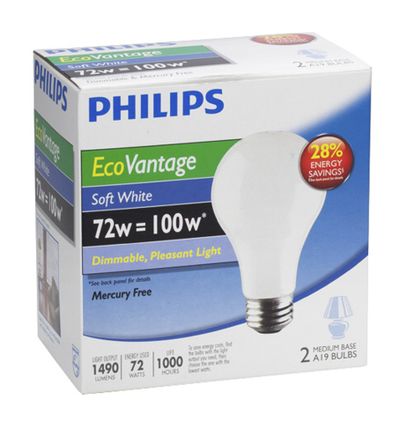Shedding light on new year
Everything you need to know about phase out of the old-fashioned bulb

These are confusing days to be shopping for a light bulb.
New federal standards were to kick in after the New Year requiring 100-watt bulbs to be more energy efficient. Then Congress, in a bill passed this month to keep the government running, blocked enforcement of the new law until October 2012.
So, is January the beginning of the end for the warm incandescent glow as we know it?
Here’s what you need to know about the phase-out of today’s standard light bulb:
First of all, what federal standards are we talking about?
The Energy Independence and Security Act became law in December 2007. It is wide-ranging, tackling topics from vehicle fuel economy and alternative automobile technologies to industrial energy efficiency, solar power and more. The law has a section that amends or tries to set new efficiency standards for appliances including furnaces, air conditioners, battery chargers, clothes washers, dishwashers and refrigerators. It also sets energy-efficiency standards for “general service incandescent lamps.”
What’s that?
It’s code for everyday-use incandescent light bulbs — the kind you screw in to the lamp in the living room. The law doesn’t cover specialty bulbs such as black lights, bug lamps or plant lights; it also doesn’t affect the 40-watt-or-less light bulbs you’d find in the refrigerator or oven.
What do the new rules demand?
Four of today’s commonly purchased incandescent bulbs are targeted: 100-watt, 75-watt, 60-watt and 40-watt. Those numbers refer to the amount of power the light bulbs draw; they’re in the crosshairs because much of the power they consume is released as heat, not light.
On Jan. 1, 2012, a bulb that puts out the same amount of light as today’s 100-watt bulb will be required to draw only 72 watts of power. In January 2013 and January 2014, similar new standards will go into effect for the other three light wattages.
Without funding for the Department of Energy to enforce the law, won’t it just be business as usual for the 100-watt incandescent bulb?
Terry McGowan, director of engineering for the American Lighting Association, an industry trade group, doesn’t think the last-minute politicking will change what the consumer sees on shelves come January. Major light-bulb makers started planning for this transition after the law passed in 2007, and have already invested in upgraded or new factories and technologies to meet the more stringent specifications.
So, does that mean incandescent bulbs will suddenly disappear from store shelves?
Not quite. Retailers will be able to keep selling their supply of 100-watt incandescents until they’re out of stock. Manufacturers can’t import or make more bulbs that draw the same amount of energy as the existing models, but they are continuing to make a new version of incandescent bulbs that meet the stricter standards.
What do I need to know when I go shopping to replace an existing 100-watt bulb?
The most useful new vocabulary word is “lumens,” a measure of the amount of light a bulb produces. An existing 100-watt bulb gives about 1,600 lumens. The Federal Trade Commission has started requiring light-bulb makers to adorn packages with a new “Lighting Facts” label that lists brightness in lumens, so you can compare.
The package label also specifies how “warm” or “cool” the bulb’s light will be. Many consumers have only a vague idea what those really mean. The Department of Energy has a useful chart online that can help you figure out whether the bulb you really like is warm or cool: www.energysavers.gov/your—home/ lighting—daylighting/index.cfm/ mytopic12030
Another phrase to watch for is “halogen incandescent.” These are the light-bulb makers’ answer to the new standards. Halogen bulbs, like regular incandescent bulbs, use a tungsten filament, so the light quality and color are intended to be similar. But in halogen bulbs, the filament is encased in a halogen gas-filled capsule that lets the filament burn hotter and more efficiently.
College kids gave halogen torchiere floor lamps a bad rap, but these newer bulbs look like regular incandescent bulbs, and they’re safer and cooler because the inner halogen tube is tucked inside a second bulb.
Does this mean I can forget about compact fluorescent lamps (CFLs) and other new kinds of light bulbs?
You might not want to. The Department of Energy says the new halogen incandescent bulbs are about 25 percent more energy-efficient than today’s bulbs. Compact fluorescent bulbs are 75 percent more efficient, last 10 times longer and, while they’re more expensive, can pay for themselves in nine months.
And while some CFLs still take a while to reach full brightness after you turn them on, the technology is improving. It’s possible to find instant-on and dimmable models that don’t bathe your living room in a glow reminiscent of the office bathroom.
Light-emitting diodes, or LEDs, are about 75 percent to 80 percent more efficient and are meant to last 25 times longer than a regular incandescent light bulb. They’re still much more expensive — $25 for a single 60-watt-equivalent bulb recently on Home Depot’s website, compared with about $5 for a five-pack of CFLs — but prices are expected to drop as more people start using them.
Excuse me, did you say $25 for a light bulb?
Yep. The upfront costs, even for certain compact fluorescent bulbs, can be hard to swallow if you’re used to paying less than $1 for incandescent bulbs, even if you know the investment will pay off down the road.
In the new era of energy-efficient lighting, we need to wrap our heads around the fact that shopping for a new light bulb is no longer akin to restocking the milk in the fridge — it’s more like purchasing an appliance, says McGowan. He keeps track of light bulb purchases, with receipts, in a file drawer right alongside repairs to his home furnace. He also recommends buying Energy Star-qualified bulbs, because they have a replacement program if the bulbs fail.